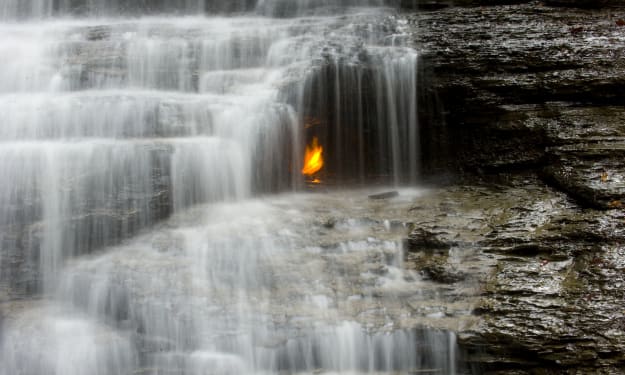
As the 20th century dawned, an intense rivalry unfolded between two polar explorers, Robert Scott and Roald Amundsen, both vying for the coveted title of the first person in history to reach the South Pole. Ultimately, tragedy befell Scott, while Amundsen emerged victorious, planting his tent at the pole before his rivals. Amidst this fierce competition, an unexpected revelation awaited British geologist Thomas Griffith Taylor, a member of Scott's expedition, at Taylor Glacier—an otherworldly waterfall of blood-red hue, now famously known as the Blood Falls.
This crimson spectacle perplexed scientists for over a century until 2011 when a team of American researchers embarked on an expedition armed with powerful electron microscopes to dissect the mysteries of Blood Falls. Previous studies had merely scratched the surface of this crimson enigma, and a full-scale analysis of its mineralogical makeup was overdue. The team's findings unveiled iron-rich nanospheres, minuscule particles akin to human red blood cells, originating from ancient microbes thriving in the meltwaters beneath Taylor Glacier. This groundbreaking discovery not only explained the eerie coloring but also hinted at the potential for life beyond Earth.
Inspired by this revelation, Dr. Ken Levy, a research scientist at John's Hopkins University with expertise in planetary materials, pondered the application of this knowledge on other planets. His curiosity led to a simulated Martian landing in Antarctica, exploring whether Mars Rovers equipped with transmission electron microscopes could unravel the mysteries of environmental materials on chilly planets. While strapping such equipment onto a Mars Rover remains impractical at present, this research marks the inception of a potential new era in space exploration.
Nature's captivating wonders extend beyond polar regions to Yosemite National Park, where Horsetail Fall undergoes a breathtaking transformation every February. As the sun sets, its rays hit the waterfall at the perfect angle, igniting a display of vibrant orange and red hues. However, witnessing this Firefall spectacle requires a unique confluence of conditions—flowing streams, warm daytime temperatures melting snow, and a clear western sky at sunset. The result is a 10-minute show that draws spectators from around the globe.
California's Death Valley National Park boasts its own mysterious phenomenon—the sailing stones of Racetrack Playa. For years, these heavy stones seemed to move mysteriously across the dry lake bed, leaving trails in the cracked mud. The puzzle stumped scientists until NASA scientist Ralph Loren applied his expertise in the behavior of ice on rocks. Using a simulated icy construction, Loren discovered that, under specific winter conditions, rocks could float across the playa, leaving their mark on the muddy terrain.
In Colombia, the river of five colors, Caño Cristales, claims the unofficial title of the most beautiful river in the world. During the wet season from September to November, the river floor, adorned with a special plant, bursts into a dazzling display of vibrant colors. The resulting living rainbow, with vibrant reds, stunning yellows, and lush greens, creates a mesmerizing spectacle that lasts for a few weeks.
The Maldives, known for its pristine beaches, unveils a magical phenomenon after sunset. Bioluminescent plankton, tiny organisms resembling underwater disco balls, emit a cool blue glow when agitated. These microscopic creatures turn the shoreline into a canvas of glowing footprints, creating a surreal spectacle that captivates anyone fortunate enough to witness it. The bioluminescent display occurs unpredictably from June to December, aligning with title currents bringing the plankton close to the shore.
In unraveling these enchanting mysteries—from polar secrets to glowing beaches—we find ourselves continuously amazed by the extraordinary beauty and intricate mechanisms that our planet harbors. These natural wonders not only showcase the wonders of science but also underscore the need for exploration and preservation to safeguard the marvels that Earth offers.





Comments
There are no comments for this story
Be the first to respond and start the conversation.